The third installment of the Bridget Jones diary series is due out soon, and it appears that Mr. Darcy is no longer a part of Bridget Jones' life. She is, by all accounts, a widow in her latest incarnation. In Mr. Darcy's place is another man, with another opportunity for sexual tension and conflict to drive the narrative.
Readers may not be aware of it, but writers know that there has to be something going on in to get the reader to turn the page and keep going to the very end. There is conflict, and then there is resolution. The problem with a series lies in maintaining that conflict, and it can be very difficult when a happy ending in the first book leads to a loss of conflict if the relationship were to continue into book three.
Bridget Jones and Mr. Darcy had become a stale, dull, married couple with children. Author Helen Fielding had no place left to go with them.
So Mr. Darcy was off-loaded and Bridget Jones trucked ahead.
Ms. Fielding's fans are up in arms over it. They wanted to read more about the couple in which they'd invested time and effort. To pick up book three and discover that they are no longer a couple? Outrageous.
 |
| Helen Fielding goes afield |
The author wanted to explore other social issues, and in the case of Mad About The Boy, she tackles the cougar phenomenon. It's perfect for Bridget Jones, of course, because the first book was all about finding the right man. Now the character can go through the same process, but with a slight twist. Ms. Fielding has aged Bridget to fifty years of age, and the character is set to pursuing a man approaching thirty.
Conflict. Sexual tension. There can't be any of that in a story about a happily married couple with children. Some wit, yes, along with some humourous situations, but the plot line had run its course as far as Ms. Fielding could judge.
She's gone not too far afield, in that latest offering explores a topic that is of greater interest to older women. What Ms. Fielding also recognizes is that those who first jumped into the diary of Bridget Jones are now ten years older, and they have different worries than they once did when they were single and looking for love like the title character of Ms. Fielding's novel. Her decision to look at December-May romance fits the demographic.
And since the fictional couple was happily married, how else would Ms. Fielding get rid of Mr. Darcy than by natural death? Divorce would not ring true, and a divorce would spoil the sense that readers developed of a satisfying conclusion to the literary romance. An accident or an unknown heart defect or whatever was required to keep the characters in character, but move the narrative in a new direction.
The possibilities that open up for a widow provide plenty of topics to develop tension and move a narrative. With Mr. Darcy gumming up the works, the narrative couldn't move.
Fans of Bridget Jones are disappointed now, but when book number four comes out, they'll have accepted the loss of Mr. Darcy and moved on. Rather like the Bridget Jones character herself.





















